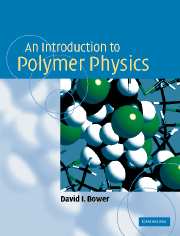Book contents
- Frontmatter
- Contents
- Preface
- Acknowledgements
- 1 Introduction
- 2 Some physical techniques for studying polymers
- 3 Molecular sizes and shapes and ordered structures
- 4 Regular chains and crystallinity
- 5 Morphology and motion
- 6 Mechanical properties I – time-independent elasticity
- 7 Mechanical properties II – linear viscoelasticity
- 8 Yield and fracture of polymers
- 9 Electrical and optical properties
- 10 Oriented polymers I – production and characterisation
- 11 Oriented polymers II – models and properties
- 12 Polymer blends, copolymers and liquid-crystal polymers
- Appendix: Cartesian tensors
- Solutions to problems
- Index
4 - Regular chains and crystallinity
Published online by Cambridge University Press: 05 June 2012
- Frontmatter
- Contents
- Preface
- Acknowledgements
- 1 Introduction
- 2 Some physical techniques for studying polymers
- 3 Molecular sizes and shapes and ordered structures
- 4 Regular chains and crystallinity
- 5 Morphology and motion
- 6 Mechanical properties I – time-independent elasticity
- 7 Mechanical properties II – linear viscoelasticity
- 8 Yield and fracture of polymers
- 9 Electrical and optical properties
- 10 Oriented polymers I – production and characterisation
- 11 Oriented polymers II – models and properties
- 12 Polymer blends, copolymers and liquid-crystal polymers
- Appendix: Cartesian tensors
- Solutions to problems
- Index
Summary
Ideal crystals are regularly repeating three-dimensional arrays of atoms. It follows that, if a polymer is to be able to crystallise, even if only to a limited extent, the minimum requirement is that its chains must themselves have regularly repeating units along their lengths and must be able to take up a straight conformation. This chapter is concerned with the types of regularity and irregularity that polymer chains can have, with how regular chains pack together and with the experimental study of the crystal structure at the level of the unit cell, the smallest unit from which the crystal may be imagined to be built by regular repetition of its structure in space, as described in section 2.5.1.
Regular and irregular chains
Introduction
It is a geometrical requirement that if a polymer is to be potentially capable of crystallising, its chains must be able, by undergoing suitable rotations around single bonds, to take up an arrangement with translational symmetry. If a polymer is actually to crystallise there is also a physical requirement: the crystal structure must usually have a lower Gibbs free energy than that of the non-crystalline structure at the same temperature. Consideration of this physical requirement is deferred to later sections; the present section deals only with the geometrical requirement.
- Type
- Chapter
- Information
- An Introduction to Polymer Physics , pp. 87 - 116Publisher: Cambridge University PressPrint publication year: 2002
- 1
- Cited by



